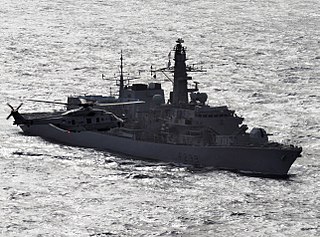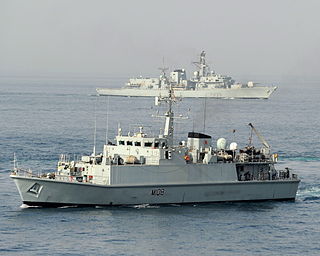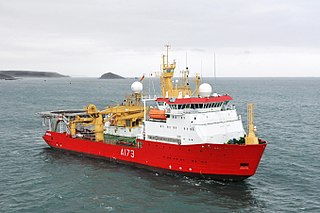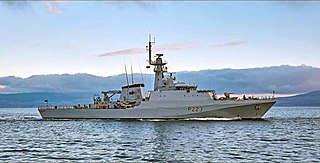Related Research Articles

The Falkland Islands are a British overseas territory and, as such, rely on the United Kingdom for the guarantee of their security. The other UK territories in the South Atlantic, South Georgia and the South Sandwich Islands, fall under the protection of British Forces South Atlantic Islands (BFSAI), formerly known as British Forces Falkland Islands (BFFI), which includes commitments from the British Army, Royal Air Force and Royal Navy. They are headed by the Commander, British Forces South Atlantic Islands (CBFSAI), a brigadier-equivalent appointment that rotates among all three services.

The third HMS Argyll was a Type 23 Duke-class frigate. Commissioned in 1991 and prior to her retirement, Argyll was the oldest serving Type 23 frigate in the Royal Navy. Like all of her class she was named after a British dukedom, in this case that of Argyll. HMS Argyll was laid down in March 1987 by Yarrow Shipbuilders at Glasgow, and launched in 1989 by Lady Wendy Levene, sponsored by the Worshipful Company of Paviors.

HMS Lancaster is a Duke-class Type 23 frigate of the Royal Navy, launched by Queen Elizabeth II on 24 May 1990. The ship is known as "The Queen's Frigate", the Duke of Lancaster being a subsidiary title of the Sovereign. Being the third ship in the Type 23 class, Lancaster was originally allocated the pennant number F232 until it was noted that the 232 is the Royal Navy report form for groundings and collisions and therefore considered unlucky. She is one of the few ships left in the fleet with some female officers but mess decks which are men-only.

HMS Richmond is a Type 23 frigate of the Royal Navy. She was launched on 6 April 1993 by Lady Hill-Norton, wife of the late Admiral of the Fleet The Lord Hill-Norton, and was the last warship to be built by Swan Hunter Shipbuilders. She sailed from the builders on the River Tyne in November 1994. She is named for the Dukedom of Richmond.

HMS Bulwark is the second ship of the Royal Navy's Albion-class assault ships. She is one of the United Kingdom's two landing platform docks designed to put Royal Marines ashore by air and by sea.

The River class is a class of offshore patrol vessels built primarily for the Royal Navy of the United Kingdom. A total of nine were built for the Royal Navy (RN), four Batch 1 and five Batch 2. One Batch 1 (HMS Clyde), which was the Falklands guard ship, was decommissioned and transferred at the end of its lease to the Royal Bahrain Naval Force.

Standing Royal Navy deployments is a list of operations and commitments undertaken by the United Kingdom's Royal Navy on a worldwide basis. The following list details these commitments and deployments sorted by region and in alphabetical order. Routine deployments made by the Navy's nuclear-powered submarines and their location of operations is classified.

HMS Mersey is a River-class offshore patrol vessel of the British Royal Navy. Named after the River Mersey, she is the fifth RN vessel to carry the name and the first to be named Mersey in 84 years. Various tenders were renamed Mersey during their service with Mersey Division Royal Naval Reserve between the early 1950s and late 1970s.

The Gibraltar Squadron is a unit of the British Royal Navy. It is the only seagoing Royal Naval unit based in Gibraltar, attached to British Forces Gibraltar. It currently includes two Cutlass-class fast patrol boats with a maximum speed of up to 41-knots. The squadron also uses three Pacific 24 rigid-hulled inflatable boats and deploys one diving support boat. The 2021 defence white paper indicated that henceforth, one River-class offshore patrol vessel, HMS Trent, would also be permanently based in Gibraltar for operations in the Mediterranean and in the Gulf of Guinea. As of 2023, 28 personnel were assigned to the squadron, along with additional personnel assigned to HMS Trent.

HMS Severn is a River-class offshore patrol vessel of the Royal Navy. Named after the River Severn, the ship is the first to bear the name in 56 years. She was built by Vosper Thornycroft in Southampton, England, to serve primarily as a fishery protection unit within the United Kingdom's waters along with her two sister ships Mersey and Tyne. All three were commissioned into service in 2003 to replace the five older Island-class patrol vessels. The ship was decommissioned in 2017, but the Government decided to recommission her as part of Brexit preparedness. She returned to service in 2020 and was recommissioned into the Royal Navy on 28 August 2021.

HMS Dauntless is the second ship of the Type 45 or Daring-class air-defence destroyers built for the British Royal Navy. She was launched at Govan in January 2007, was handed over to the Royal Navy on 3 December 2009 and was formally commissioned on 3 June 2010.

HMS Duncan is the sixth and last of the Type 45 or Daring-class air-defence destroyers built for the Royal Navy and launched in 2010. Duncan is named after Adam Duncan, 1st Viscount Duncan, who defeated the Dutch fleet at the Battle of Camperdown on 11 October 1797. The destroyer has served in the Mediterranean, Black, and Caribbean Seas, and in 2019 was deployed to the Persian Gulf in response to increased tensions with Iran in the region. In May 2024, she deployed to the Red Sea to protect international shipping from the ongoing Houthi attacks.

HMS Grimsby was a Sandown-class minehunter of the British Royal Navy, serving from 1999–2022, and the second ship to bear the name.

HMS Protector is a Royal Navy ice patrol ship built in Norway in mid 2000. As MV Polarbjørn she operated under charter as a polar research icebreaker and a subsea support vessel. In 2011, she was chartered as a temporary replacement for the ice patrol ship HMS Endurance and was purchased by the British Ministry of Defence in early September 2013. As DNV Ice Class 05 the vessel can handle first year ice up to 0.5 metres (20 in).

HMS Forth is a Batch 2 River-class offshore patrol vessel in active service with the Royal Navy. Named after the River Forth, she is the first Batch 2 River-class vessel to be built. She was commissioned into the Royal Navy on 13 April 2018, following a commissioning ceremony at her homeport HMNB Portsmouth. In January 2020 she replaced HMS Clyde as the Falkland Islands patrol ship.

HMS Medway is a Batch 2 River-class offshore patrol vessel for the Royal Navy. Named after the River Medway in Kent, she was the second Batch 2 River-class vessel to be commissioned and is assigned long-term as Royal Navy guardship in the Caribbean.

HMS Trent is a Batch 2 River-class offshore patrol vessel, named after the River Trent. This is the sixth Royal Navy ship named Trent. She is the third Batch 2 River-class vessel to be commissioned and is forward deployed to Gibraltar for operations in the Mediterranean and Gulf of Guinea.

HMS Tamar is a Batch 2 River-class offshore patrol vessel of the Royal Navy. Named after the River Tamar in England, she is the fourth Batch 2 River-class vessel to be built and is forward deployed long-term to the Indo-Pacific region with her sister ship HMS Spey.

HMS Spey is a Batch 2 River-class offshore patrol vessel of the Royal Navy. Named after the River Spey in Scotland, she is the eighth Royal Navy ship to be named Spey and is the fifth Batch 2 River-class vessel to commission and is forward deployed long-term to the Indo-Pacific region with her sister ship HMS Tamar.
References
- ↑ "HMS Lancaster to visit the British Virgin Islands".
- ↑ "HMS Medway Sets Sail for the Caribbean". Royal Navy. 20 January 2019. Retrieved 1 October 2020.
- ↑ "HMS Dauntless visits trio of Caribbean Islands in disaster relief preparation mission". Royal Navy. 4 October 2023. Retrieved 4 October 2023.
- ↑ @NavyLookout (16 August 2024). "@NavyLookout. @HMSTrent arrived in Tortola, 🇻🇬British Virgin Islands yesterday ready to provide practical help following Tropical Storm #Ernesto" (Tweet). Retrieved 16 August 2024– via Twitter.
- ↑ "Vicadets".
- ↑ "Double celebration for HMS Mersey in British Virgin Islands | Royal Navy".
- ↑ "Vicadets".